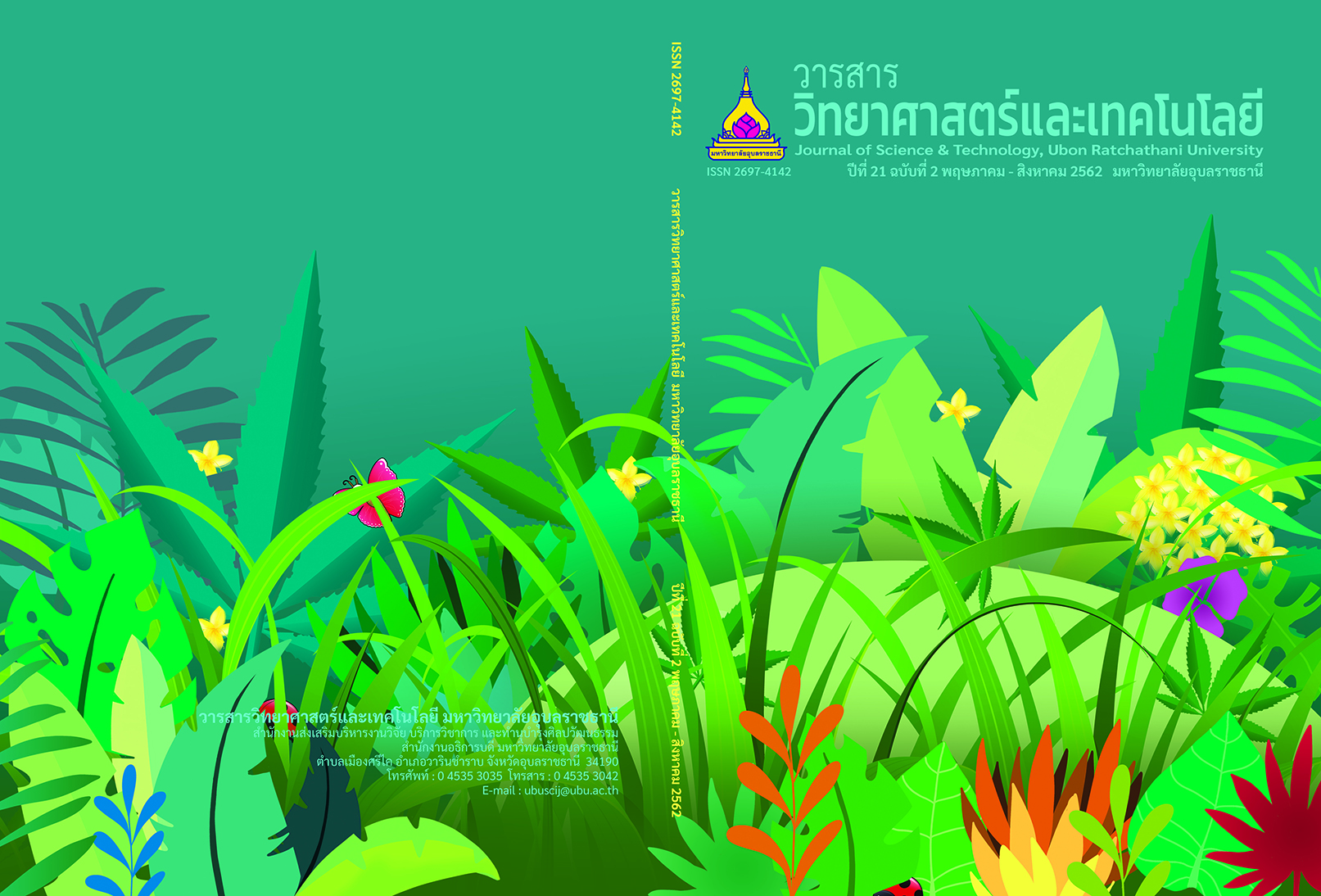ปัจจัยที่มีความสัมพันธ์กับการมารับบริการวัคซีนพิษสุนัขบ้าหลังสัมผัสโรค อำเภอกันทรารมย์ จังหวัดศรีสะเกษ
Main Article Content
บทคัดย่อ
การวิจัยเชิงสำรวจนี้มีวัตถุประสงค์เพื่อศึกษาปัจจัยที่มีความสัมพันธ์กับการมารับบริการวัคซีนพิษสุนัขบ้าหลังสัมผัสโรค อำเภอกันทรารมย์ จังหวัดศรีสะเกษ กลุ่มตัวอย่าง 335 คน โดยใช้แบบสัมภาษณ์เก็บข้อมูล ผลการวิจัยพบว่าผู้มารับบริการวัคซีนพิษสุนัขบ้าหลังสัมผัสโรค เป็นเพศหญิงร้อยละ 50.4 อายุเฉลี่ย 44.46 ปี สถานภาพสมรสร้อยละ 54.3 สำเร็จการศึกษาชั้นมัธยมศึกษาร้อยละ 35.2 อาชีพเกษตรกรร้อยละ 32.8 รายได้เฉลี่ย 7,198.31 บาท สิทธิการรักษาบัตรทอง 30 บาทร้อยละ 79.1 ระยะทางเฉลี่ยจากบ้านมาโรงพยาบาล 11.12 กิโลเมตร ใช้รถมอเตอร์ไซด์มารับบริการร้อยละ 48 สัตว์ที่สัมผัสมากที่สุดคือสุนัขร้อยละ 77.6 ไม่ทราบประวัติการได้รับวัคซีนของสัตว์ร้อยละ 73.4 ระดับการสัมผัสโรคตาม WHO category ระดับ 3 มารับบริการมากที่สุดร้อยละ 62.4 ผู้มารับบริการวัคซีนพิษสุนัขบ้ามีคะแนนความรู้ ทัศนคติ การรับรู้ และปัจจัยสนับสนุนระดับปานกลาง คะแนนปัจจัยเอื้ออยู่ในระดับสูง
ปัจจัยที่มีความสัมพันธ์กับการมารับวัคซีนครบตามกำหนดนัดอย่างมีนัยสำคัญทางสถิติ ได้แก่ ความรู้(2=9.276,p<0.05) ปัจจัยที่มีความสัมพันธ์กับการทำความสะอาดแผลหลังสัมผัสสัตว์อย่างมีนัยสำคัญทางสถิติ(p<0.05) ได้แก่ เพศ อายุ การศึกษา อาชีพ รายได้ สิทธิการรักษาพยาบาล ชนิดของสัตว์ที่สัมผัส ระดับการสัมผัส ความรู้ ทัศนคติ และปัจจัยสนับสนุน การวิจัยในครั้งนี้มีข้อเสนอแนะให้ดำเนินการส่งเสริมความรู้แก่ประชาชน โดยเน้นเรื่องชนิดของสัตว์ที่สามารถนำเชื้อพิษสุนัขบ้ามาสู่คน ความจำเป็นในการกักขังดูอาการสัตว์หลังจากโดนข่วนหรือกัด และส่งเสริมการล้างแผลซึ่งจะช่วยลดปริมาณเชื้อโรคเข้าสู่ร่างกายได้
Article Details
บทความที่ได้รับการตีพิมพ์เป็นลิขสิทธิ์ของ วารสารวิทยาศาสตร์และเทคโนโลยี มหาวิทยาลัยอุบลราชธานี
ข้อความที่ปรากฏในบทความแต่ละเรื่องในวารสารวิชาการเล่มนี้เป็นความคิดเห็นส่วนตัวของผู้เขียนแต่ละท่านไม่เกี่ยวข้องกับมหาวิทยาลัยอุบลราชธานี และคณาจารย์ท่านอื่นๆในมหาวิทยาลัยฯ แต่อย่างใด ความรับผิดชอบองค์ประกอบทั้งหมดของบทความแต่ละเรื่องเป็นของผู้เขียนแต่ละท่าน หากมีความผิดพลาดใดๆ ผู้เขียนแต่ละท่านจะรับผิดชอบบทความของตนเองแต่ผู้เดียว
เอกสารอ้างอิง
[2] Kumpeeraparp, G.2017 “Rabies” in Journal of Department of Medicine Service, 42 (5):10-12. (in Thai)
[3] Puanghut,A and et al..2009. Strategic Plan for Zero Rabies in Thailand by 2020.Bureau of General Communicable Disease Department of Disease Control MOPH Thailand. (in Thai)
[4] Theerawut, R.2017. Guidelines for the Prevention of Rabies Control. Bureau of General Communicable Disease Department of Disease Control MOPH Thailand. (in Thai)
[5]. The Office of Disease Prevention and Control 7 Khon Kaen.2016. https://odpc7.ddc.moph.go.th/archives. Accessed 11 February 2018. (in Thai)
[6] Thai Rabie Information System for Rabies Surveillance.2561. https://www.thairabies.net/trn/Default_Main.aspx. Accessed 19 February 2018. (in Thai)
[7] Green, L. W., & Kreuter, M. W. 1991. Health Promotion Planning (2). Mountain View: Mayfield Publishing
[8] Becker, M. H., & Maiman. 1975. Sociobehavior Determinants of Compliance with Health and Medicine Care Recommendation (Vol. 8). L.A.
[9] Boonnuch, C and Katesumpun,Y. 2011. Sample Size in Quantitative Research. Community Handbook. Faculty of Medicine Siriraj Hospital, Mahidol University. (in Thai)
[10] Studies rabies exposure in Ban Tak Tak Province Year 2016.:https://bantakhospital.go.th/file/94479964020170118_232126.pdf.Accessed 1 May 2018. (in Thai)
[11] Tangkaeng, P.2014. Factors associated with vaccination failure of animals exposed Phrom Khiri Hospital Nakhon Sri Thammarat: https://www.promkiri.go.th/detail/doc_download/a_230414_144848.pdf. Accessed 11 January 2018. (in Thai)
[12] Jimetum, S.2000.Behaviours for Rabies Prevention among Anti-Rabies Vaccinated cases at Health Facilities in Phetcahburi Province.M.Sc. Thesis, Srinakarinwirot University. (in Thai)
[13] Watcharanurak,P and Klubklay,A.2017. “Factors Influencing Preventive Behavior among Stoke-Risk Patients in Songkhla Province” in The Southern College Network Journal of Nursing and Public Health,4(1): (217-233) (in Thai)
[14] Yaengkulchow, W .2015. Factors related to family health promoting behaviors. In the area of responsibility of the Ban Chang Health Promotion Hospital Nakhon Sri Thammarat. https://www.vcharkarn.com/blog/118108. Accessed 9 March 2018 (in Thai)
[15] Puanghut,A and et al.2016. Rabies treatment guidelines and FAQs. 2016. Bureau of General Communicable Disease Department of Disease Control MOPH Thailand. (in Thai)
[16] Rabies vaccines and immunoglobulins: WHO position https://www.who.int/neglected_diseases/news/Rabies_WHO_has_published_new_recommendations_for_immunization/en/. Accessed 14 July 2018


